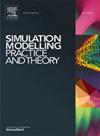Underground rescue path planning based on a comprehensive risk assessment approach
IF 3.5
2区 计算机科学
Q2 COMPUTER SCIENCE, INTERDISCIPLINARY APPLICATIONS
引用次数: 0
Abstract
Fire incidents in underground environments, such as subway stations and shopping malls, pose significant hazards due to restricted ventilation and confined spaces. These conditions complicate rescue operations, particularly given the unpredictable nature of fires. Effective integration of fire risk assessment into rescue path planning is essential for ensuring both safety and operational efficiency. However, fire risk is inherently complex, varying across both temporal and spatial dimensions, and accurate assessment depends on precise fire situation inference. Despite advancements in fire simulation technologies, inconsistencies in geometric structures between computational units limit seamless integration with path planning models. Consequently, many existing studies rely on simplistic and less reliable linear fire inference models, compromising the safety of rescue operations. This paper addresses these challenges by proposing an underground rescue path planning method based on a comprehensive fire risk assessment, aimed at enhancing both safety and operational efficiency. A fire risk assessment approach, driven by fire situation inference, is introduced, employing a novel grid-matching transformation to capture the spatio-temporal dynamics of fire conditions using high-precision simulation software. Additionally, an improved A* algorithm is developed for real-time rescue path optimization, minimizing path risk based on the results of the risk assessment. The proposed method is validated through a detailed case study, demonstrating its effectiveness and reliability.
基于综合风险评估方法的地下救援路径规划
在地铁站和购物中心等地下环境中发生火灾时,由于通风受限和空间狭小,会造成极大的危险。这些条件使救援行动变得更加复杂,特别是考虑到火灾的不可预测性。将火灾风险评估有效纳入救援路径规划对于确保安全和运营效率至关重要。然而,火灾风险本身就很复杂,在时间和空间维度上都各不相同,准确的评估取决于精确的火灾情况推断。尽管火灾模拟技术不断进步,但计算单元之间几何结构的不一致性限制了与路径规划模型的无缝集成。因此,许多现有研究都依赖于简单且可靠性较低的线性火灾推断模型,从而影响了救援行动的安全性。本文针对这些挑战,提出了一种基于全面火灾风险评估的地下救援路径规划方法,旨在提高安全性和操作效率。本文介绍了一种由火灾情况推断驱动的火灾风险评估方法,采用了一种新颖的网格匹配变换,利用高精度模拟软件捕捉火灾情况的时空动态。此外,还开发了一种改进的 A* 算法,用于实时优化救援路径,根据风险评估结果最大限度地降低路径风险。通过详细的案例研究对所提出的方法进行了验证,证明了其有效性和可靠性。
本文章由计算机程序翻译,如有差异,请以英文原文为准。
求助全文
约1分钟内获得全文
求助全文
来源期刊

Simulation Modelling Practice and Theory
工程技术-计算机:跨学科应用
CiteScore
9.80
自引率
4.80%
发文量
142
审稿时长
21 days
期刊介绍:
The journal Simulation Modelling Practice and Theory provides a forum for original, high-quality papers dealing with any aspect of systems simulation and modelling.
The journal aims at being a reference and a powerful tool to all those professionally active and/or interested in the methods and applications of simulation. Submitted papers will be peer reviewed and must significantly contribute to modelling and simulation in general or use modelling and simulation in application areas.
Paper submission is solicited on:
• theoretical aspects of modelling and simulation including formal modelling, model-checking, random number generators, sensitivity analysis, variance reduction techniques, experimental design, meta-modelling, methods and algorithms for validation and verification, selection and comparison procedures etc.;
• methodology and application of modelling and simulation in any area, including computer systems, networks, real-time and embedded systems, mobile and intelligent agents, manufacturing and transportation systems, management, engineering, biomedical engineering, economics, ecology and environment, education, transaction handling, etc.;
• simulation languages and environments including those, specific to distributed computing, grid computing, high performance computers or computer networks, etc.;
• distributed and real-time simulation, simulation interoperability;
• tools for high performance computing simulation, including dedicated architectures and parallel computing.
 求助内容:
求助内容: 应助结果提醒方式:
应助结果提醒方式:


